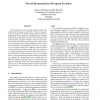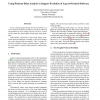114
click to vote
ICSM
2005
IEEE
15 years 6 months ago
2005
IEEE
In this ever changing business environment, business processes are constantly being customized to reflect the up-to-date organizational structure and business objectives. Technolo...
102
click to vote
ICSM
2005
IEEE
15 years 6 months ago
2005
IEEE
Large-scale legacy programs take long time to compile, thereby hampering productivity. This paper presents algorithms that reduce compilation time by analyzing syntactic dependenc...
118
click to vote
ICSM
2005
IEEE
15 years 6 months ago
2005
IEEE
Several rapid-feedback-based quality assurance mechanisms are used to manage the quality of continuously evolving software. Even though graphical user interfaces (GUIs) are one of...
102
click to vote
ICSM
2005
IEEE
15 years 6 months ago
2005
IEEE
To aid software analysis and maintenance tasks, a number of software clustering algorithms have been proposed to automatically partition a software system into meaningful subsyste...
127
click to vote
ICSM
2005
IEEE
15 years 6 months ago
2005
IEEE
Regression testing is a widely-used method for checking whether modifications to software systems have adversely affected the overall functionality. This is potentially an expens...
100
Voted
ICSM
2005
IEEE
15 years 6 months ago
2005
IEEE
There can be no doubt that risk management is an important activity in the software engineering area. One proof of this is the large body of work existing in this area. However, w...
ICSM
2005
IEEE
15 years 6 months ago
2005
IEEE
This paper presents the Xrefactory project. Xrefactory is a plugin to editors and Integrated Development Environments (IDE) providing a variety of source understanding and refacto...
96
Voted
ICSM
2005
IEEE
15 years 6 months ago
2005
IEEE
The documentation of a program often falls behind the evolution of the program source files. When this happens it may be attractive to shift the documentation mode from updating ...
111
Voted
ICSM
2005
IEEE
15 years 6 months ago
2005
IEEE
Adding distributed capabilities to existing programs has come to the forefront of software evolution. As a standard Java distributed technology, applets offer the advantages of be...
124
Voted
ICSM
2005
IEEE
15 years 6 months ago
2005
IEEE
Aspect oriented programming has been proposed as a way to improve modularity of software systems by allowing encapsulation of cross-cutting concerns. To do so, aspects specify whe...


